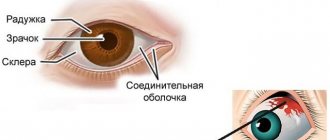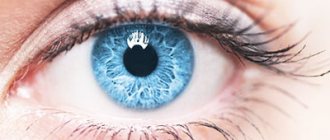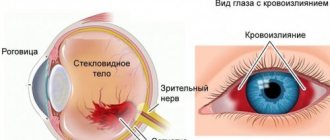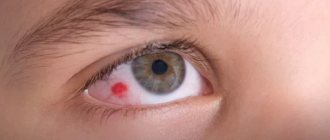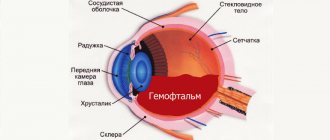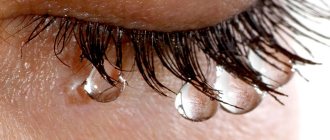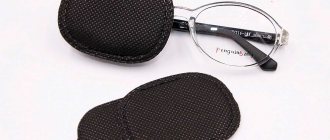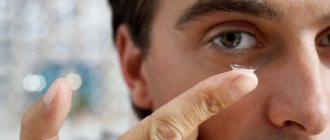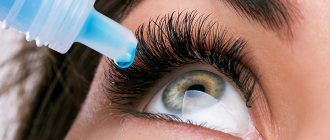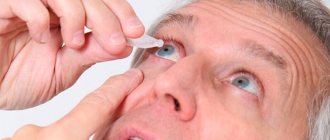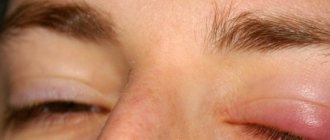When a vessel in the eye bursts, only a doctor can determine what can be done to prevent the problem from recurring. A capillary rupture indicates negative processes in the body, especially if this is not an isolated incident, but a frequently recurring incident. A person must undergo a comprehensive examination and a prescribed therapeutic course. Only a responsible attitude towards health will prevent recurrent hemorrhages.
Causes of capillary damage
The causes of capillary damage include the following factors:
- Jumps in blood pressure (BP), but more often hypertension. A sharp change in blood pressure levels causes disturbances in the functional activity of the vessels of the eyeball, which, on the one hand, reduces the strength and elasticity of the capillaries, and on the other, promotes blood thickening. As a result, the amount of blood in the vessels increases and damage occurs.
- Eye injuries (bruises, blows from a fall or fight). Mechanical damage to the eyeball causes disruption of the integrity of blood vessels and provokes hemorrhage in the whites of the eye.
- Recent surgery. After ophthalmic surgery, patients may experience subconjunctival hemorrhage, which is often mistaken for a hematoma.
- Physical overexertion. During sports training or lifting weights, the vessel may burst. Sometimes this happens during contractions in pregnant women.
- Diabetes . Due to an increase in blood glucose levels, the elasticity of blood vessels decreases and rupture occurs.
- High loads on the visual apparatus. Working at a computer for a long time, watching movies/series or reading in poor lighting leads to damage to the eye capillaries.
- Meteosensitivity. Eyes may turn red when there are sudden changes in temperature or atmospheric pressure, as well as when the climate changes (for example, when moving to another city or country).
- Conjunctivitis (inflammation of the mucous membrane of the eye of bacterial, viral or allergic etiology). Reproducing bacteria, viruses and fungi contribute to profuse redness of the eyeball, simultaneously causing cutting pain, burning and photophobia.
Expert opinion
Nosova Yulia Vladimirovna
Ophthalmologist of the highest category. Candidate of Medical Sciences.
Damage to blood vessels can be caused by unfavorable weather conditions (sharp gusty winds, bright sun, etc.), excessively dry indoor air (including accumulation of dust in the absence of regular wet cleaning), as well as small foreign objects falling on the mucous membrane eyes (mote, dust, sand, etc.).
At-risk groups
The following categories of people are considered at risk:
- Hypertension - increased blood pressure has a negative effect on the brain and retina, which leads to damage to blood vessels.
- Diabetics - due to increased glucose levels, the capillary walls become thinner and subsequently damaged.
Also at risk are people suffering from vitamin deficiency (in particular, those lacking ascorbic acid), athletes, pregnant women and women in labor, patients who have suffered viral diseases, heart attack or stroke.
What drugs should not be used?
If a vessel has burst in the eye, drops that have a vasoconstrictor effect are strictly contraindicated, since they slow down the resorption of blood and contribute to the formation of a pigment spot. Such drugs include:
- Afrin is a nasal remedy for topical use that constricts the arterioles of the nasal mucosa, reducing redness and swelling. Used in the treatment of sinusitis, rhinitis, allergic rhinitis, etc.
- Octilya - eye drops with a vasoconstrictor effect, relieve inflammation, redness and swelling. They are used as part of complex therapy to treat irritation of the mucous membrane caused by physical, chemical or allergic factors (bright lighting, smoke, dust particles, etc.).
- Naphthyzin is a nasal drop that has a vasoconstrictor effect. Used for acute rhinitis, sinusitis, laryngitis, etc.
- Alomide is an ophthalmic drop with an antiallergic effect. Used to treat conjunctivitis, keratoconjunctivitis, etc.
The use of these drugs is permissible only after preliminary consultation with a specialist, and in the dosage strictly recommended by him.
What to do
If a blood vessel under your eye bursts, you should never rub it. This may make the problem even worse. In most cases, no special treatment is required, especially if the bleeding is minor. After some time it will resolve on its own. If the cause is an underlying disease (diabetes mellitus, hypertension), adverse effects of environmental conditions and other factors, they must be eliminated. This will help avoid re-rupture.
Pharmacy drops
If a capillary in the eye bursts, what to do to speed up the resorption of the hemorrhage is of interest to many, since this leads not only to an aesthetic problem, but also to impaired visual acuity. Only a doctor can choose effective drops after examining the patient. It is strictly forbidden to decide on your own about the need to use medications, since incorrectly selected medications can cause even more harm.
If minor bleeding occurs, you can use:
- Visin eye drops. Relieves irritation and swelling. Reduce discomfort - pain and burning. Promotes resorption of hemorrhage. Moisturizes the mucous membrane of the eye. The medicine must be administered 2-3 times a day, 2 drops.
- Emoxipin. Refers to capillary stabilizing agents. Promotes rapid regression of hematoma. You need to use the medicine 2-3 drops several times a day. The duration of treatment depends on the size of the hemorrhage, ranging from several days to 2-3 weeks.
- Hyphenation. Eye drops that provide effective hydration of the conjunctiva. This is necessary in order to prevent the mucous membrane from drying out; the vessels can burst with dry eye syndrome.
- Taufon. The main active ingredient of the drug is taurine, which is an amino acid. Provides regeneration and restoration of damaged tissues. Promotes rapid healing of microcracks and exhibits trophic properties. Normalizes metabolic processes. Even people suffering from glaucoma can take the drug.
Drops from folk remedies
You can find information about what to do if a blood vessel bursts in your eye in folk recipes. These remedies are recommended to be used only for minor hemorrhages, when the main functions of the organ are not impaired and the problem is purely cosmetic.
Important information: Can uterine fibroids bleed and how to stop uterine bleeding
Immediately after a capillary rupture, it is recommended to apply cold. This will narrow the blood vessels and prevent further leakage of blood. To do this, apply an ice cube to the eyelid area. As an alternative, you can use a slice of cucumber, avocado, or raw potato. They will help remove redness and inflammation. You can drop fresh cabbage juice into your eyes (1 drop 2-3 times a day).
The most common method used when capillaries in the eye burst is strong tea leaves. Soak a cotton pad in a warm solution and apply it to your eyelids for 5-10 minutes. After which the tea leaves should be washed off with cool water. You need to treat your eyes several times a day.
For burst blood vessels, you can use compresses based on medicinal plants. Chamomile, linden and mint flowers have anti-inflammatory, antiseptic, wound-healing, and absorbent properties. To do this, make an infusion based on 2 tbsp. l. dry crushed collection and 1 cup of hot water. Compresses should be applied 1-2 times a day.
How to use the products correctly?
The effectiveness of treating a ruptured vessel largely depends on the correct use of ophthalmic drops. So, experts recommend:
- Do not use medications that have expired (indicated on the packaging).
- Before using the drops, wash your hands thoroughly with disinfectant soap.
- Remove lenses before the instillation procedure. You can put on lenses no earlier than 20 minutes after administration of the drug.
- Use the drops exactly in the dosage and exactly the number of times prescribed by your doctor.
The procedure for administering drops is as follows:
- The patient tilts his head back slightly.
- Gently pull back the lower eyelid with the index finger of the right hand (left-handed people can use the opposite hand) and squeeze out the required number of drops (usually no more than 2).
- Keep the eye open for 2-3 seconds, then close it and remove any remaining product from the skin with a dry cloth.
- If necessary, perform the same procedure for the other eye.
Attention! In case of an overdose of the drug or an allergic reaction (itching, lacrimation, etc.), treatment must be suspended and consult a specialist.
When should you see a doctor?
In most cases, ruptured blood vessels can be cured on your own without the help of a doctor. For this purpose, special eye drops and traditional medicine are used. However, in the event of a hematoma (or extensive redness of the mucous membrane), it is necessary to consult a doctor as soon as possible. A visit to an ophthalmologist is also required in cases where redness is accompanied by pain, burning, intolerance to bright light, and increased lacrimation.
Features of treatment for children
Every fifth newborn has ruptured blood vessels in the eye. If labor stimulation was used, this happens in 40% of cases. This happens because the baby’s blood vessels are very fragile, and the pressure on them is unusually high. However, newborns quickly adapt to the environment, and this does not happen again in the future. This pathology in children does not require treatment and goes away on its own.
Sometimes, with strong crying or sudden head lifting, an older child may burst a blood vessel in the eye. In this case, treatment with medications is not advisable. For children, a compress of raw potatoes or a tea bag is enough, the pain will go away, and the hematoma itself in a child resolves much faster than in an adult. If the hemorrhage is too extensive, you should visit an ophthalmologist, he will recommend instilling moisturizing drops. You should not treat hemorrhages with drops on your own.
You can cure the consequences of a broken capillary in the eye with the help of eye drops or folk remedies, but you cannot remove the red spot itself; it only goes away on its own.
Prevention of capillary rupture
Ophthalmologists say that ruptured blood vessels can be avoided if you follow the following rules:
- Perform special eye exercises every day (rotating the eyeballs in a circle, blinking frequently for 30 seconds, keeping your gaze on one point, etc.).
- Give your eyes the necessary rest (once an hour when working at the computer for a long time or when reading).
- Monitor your blood pressure and contact a specialist in a timely manner.
- Eat properly. The diet should include fresh fruits and vegetables (citrus fruits, apricots, persimmons, cabbage of all types, etc.).
- When working at a computer, stay at a safe distance from the monitor - within 25–30 cm.
- Clean your eyes daily from makeup and other external influences (wind, dust, sand, etc.). To do this, you need to rinse your eyes with warm or cool water, first removing dirt from the eyelashes.
- Drink vitamin and mineral complexes regularly.
Symptoms
This pathology has one pronounced sign - a reddened eye with a bloody spot on it. It can be very small and barely noticeable if only one capillary has burst, or it can cover the entire front part of the eyeball if there are several vessels that have burst. It is worth noting that redness can only be observed if the torn vessel is located on the front visible part of the eye, but it can also be located behind. In this case, you will feel a slight heaviness in your eyes.
Reviews
User reviews will help you better navigate choosing the right product. Here are some of them:
Tatyana, 32 years old:
I work a lot at the computer, so my eyes often become overstrained and capillaries break, hence the redness and dryness. The ophthalmologist recommended Taufon and Defislez to me. I have been using these drugs for 2 months now and am quite pleased with the results.
Mikhail, 46 years old:
Due to high blood pressure (I have been hypertensive since my youth), blood vessels in my eyes began to burst and my vision deteriorated. The doctor prescribed me Emoxipin drops and Ascorutin tablets. After 1.5 months of therapy, the situation stabilized.
Victoria, 55 years old:
I didn’t have any problems with my eyes before, but diabetes is making itself felt. And for the past 3 years, the eye capillaries have been bursting on a regular basis. As a local therapy, the ophthalmologist prescribed me Quinax and Taufon drops. I've been using it for a month now, but to no avail.
“Taufon”
The drug is classified as an ophthalmic drug for local use.
“Taufon” is produced in the form of eye drops. The drug is sold in bottles of five and ten milliliters. The medicine can be purchased without a prescription.
One milliliter of the medicine contains forty milligrams of the main active microelement - taurine; water acts as additional substances.
There is no clinical information about the use of the drug to treat the eyes of women in an “interesting situation.” “Taufon” is not prescribed for therapy during lactation, since there is no information on its use. If it is necessary to carry out therapy with the drug “Taufon” during breastfeeding, it is necessary to resolve the issue of stopping lactation.
